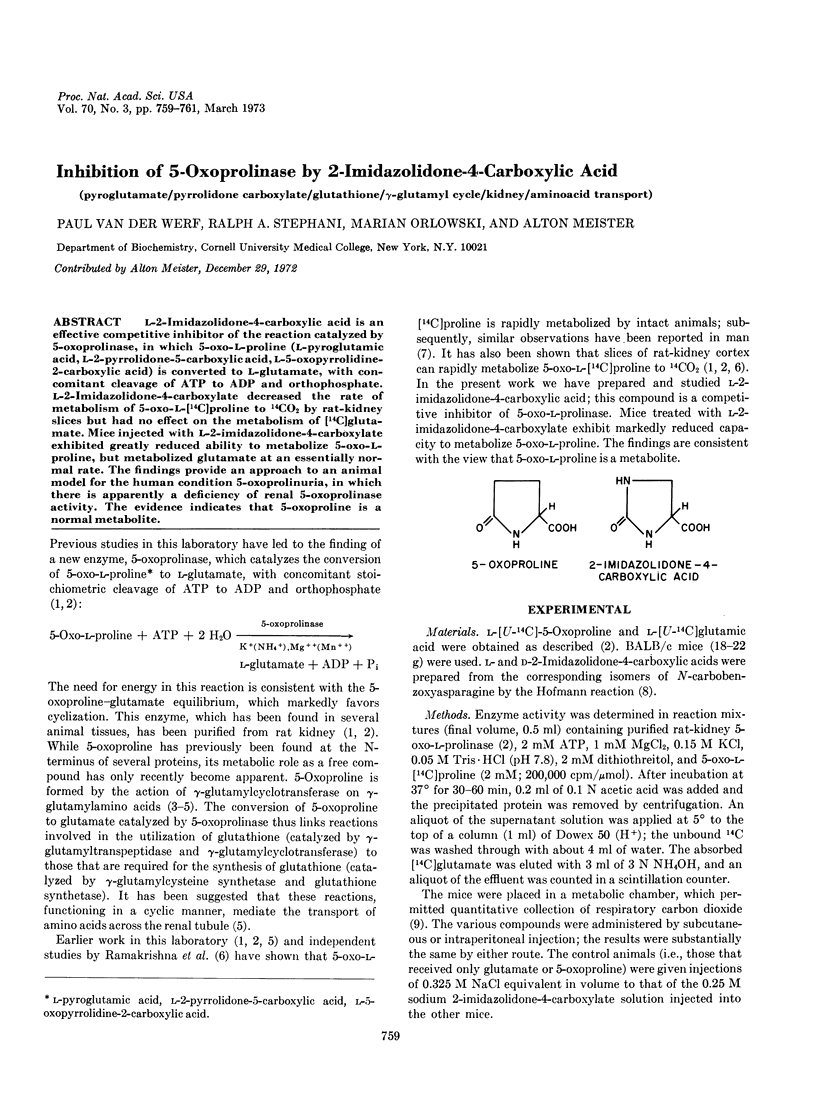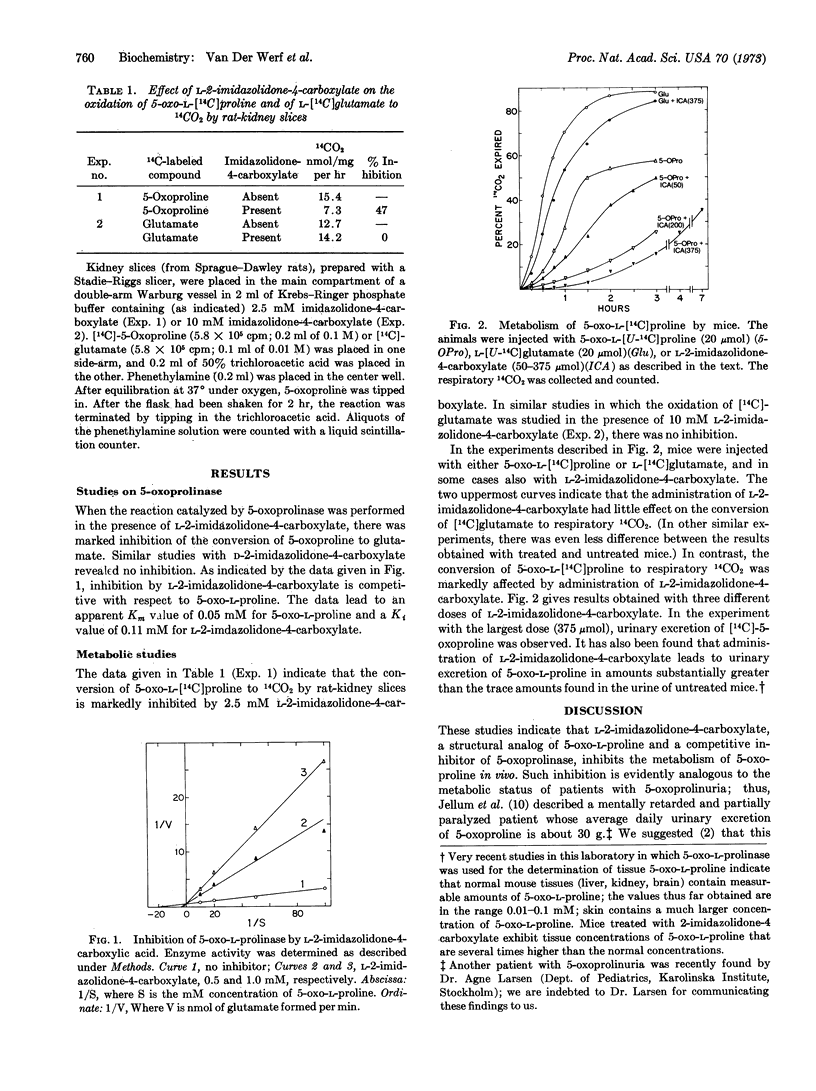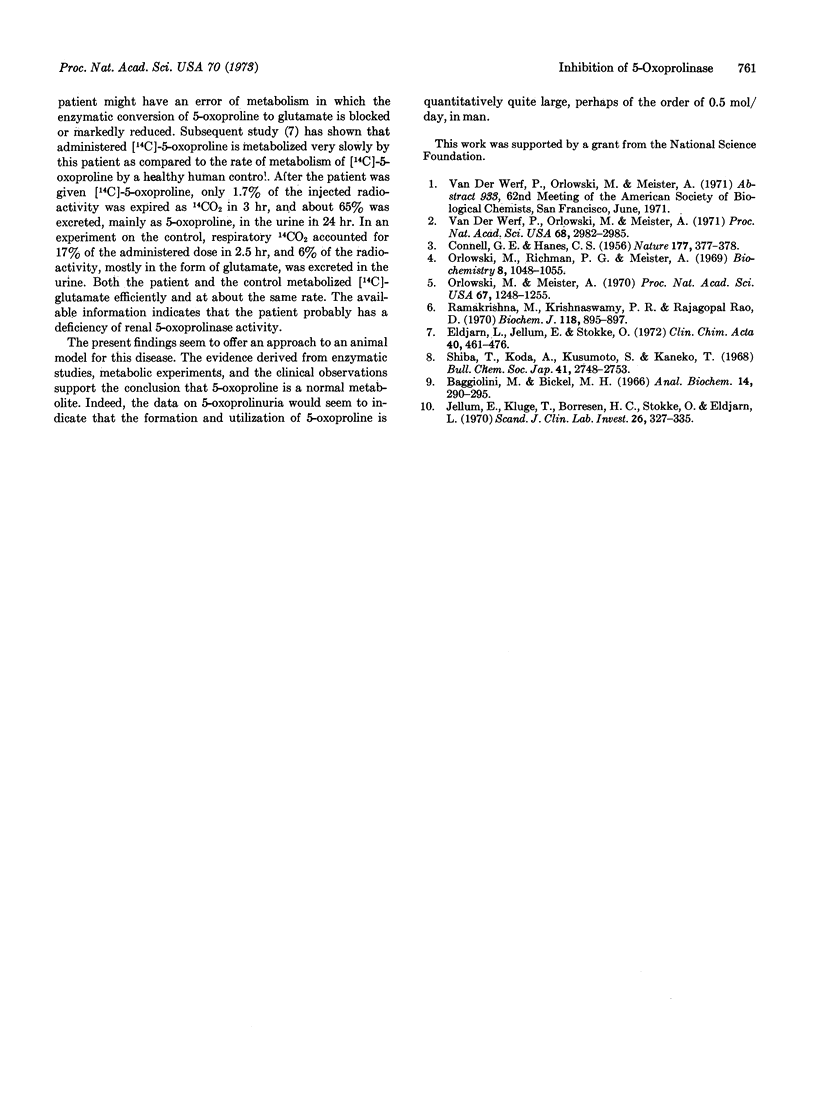Abstract
L-2-Imidazolidone-4-carboxylic acid is an effective competitive inhibitor of the reaction catalyzed by 5-oxoprolinase, in which 5-oxo-L-proline (L-pyroglutamic acid, L-2-pyrrolidone-5-carboxylic acid, L-5-oxopyrrolidine-2-carboxylic acid) is converted to L-glutamate, with concomitant cleavage of ATP to ADP and orthophosphate. L-2-Imidazolidone-4-carboxylate decreased the rate of metabolism of 5-oxo-L-[14C]proline to 14CO2 by rat-kidney slices but had no effect on the metabolism of [14C]glutamate. Mice injected with L-2-imidazolidone-4-carboxylate exhibited greatly reduced ability to metabolize 5-oxo-L-proline, but metabolized glutamate at an essentially normal rate. The findings provide an approach to an animal model for the human condition 5-oxoprolinuria, in which there is apparently a deficiency of renal 5-oxoprolinase activity. The evidence indicates that 5-oxoproline is a normal metabolite.
Keywords: pyroglutamate, pyrrolidone carboxylate, glutathione, γ-glutamyl cycle, kidney, aminoacid transport
Full text
PDF


Selected References
These references are in PubMed. This may not be the complete list of references from this article.
- Baggiolini M., Bickel M. H. A new type of incubation apparatus for the determination of metabolically produced 14CO-2. Anal Biochem. 1966 Feb;14(2):290–295. doi: 10.1016/0003-2697(66)90139-4. [DOI] [PubMed] [Google Scholar]
- CONNELL G. E., HANES C. S. Enzymic formation of pyrrolidone carboxylic acid from gamma-glutamyl peptides. Nature. 1956 Feb 25;177(4504):377–378. doi: 10.1038/177377a0. [DOI] [PubMed] [Google Scholar]
- Eldjarn L., Jellum E., Stokke O. Pyroglutamic aciduria: studies on the enzymic block and on the metabolic origin of pyroglutamic acid. Clin Chim Acta. 1972 Sep;40(2):461–476. doi: 10.1016/0009-8981(72)90359-2. [DOI] [PubMed] [Google Scholar]
- Jellum E., Kluge T., Börresen H. C., Stokke O., Eldjarn L. Pyroglutamic aciduria--a new inborn error of metabolism. Scand J Clin Lab Invest. 1970 Dec;26(4):327–335. doi: 10.3109/00365517009046241. [DOI] [PubMed] [Google Scholar]
- Orlowski M., Meister A. The gamma-glutamyl cycle: a possible transport system for amino acids. Proc Natl Acad Sci U S A. 1970 Nov;67(3):1248–1255. doi: 10.1073/pnas.67.3.1248. [DOI] [PMC free article] [PubMed] [Google Scholar]
- Orlowski M., Richman P. G., Meister A. Isolation and properties of gamma-L-glutamylcyclotransferase from human brain. Biochemistry. 1969 Mar;8(3):1048–1055. doi: 10.1021/bi00831a036. [DOI] [PubMed] [Google Scholar]
- Ramakrishna M., Krishnaswamy P. R., Rao D. R. Metabolism of pyrrolidonecarboxylic acid in the rat. Biochem J. 1970 Aug;118(5):895–897. doi: 10.1042/bj1180895. [DOI] [PMC free article] [PubMed] [Google Scholar]
- Van der Werf P., Orlowski M., Meister A. Enzymatic conversion of 5-oxo-L-proline (L-pyrrolidone carboxylate) to L-glutamate coupled with cleavage of adenosine triphosphate to adenosine diphosphate, a reaction in the -glutamyl cycle. Proc Natl Acad Sci U S A. 1971 Dec;68(12):2982–2985. doi: 10.1073/pnas.68.12.2982. [DOI] [PMC free article] [PubMed] [Google Scholar]


